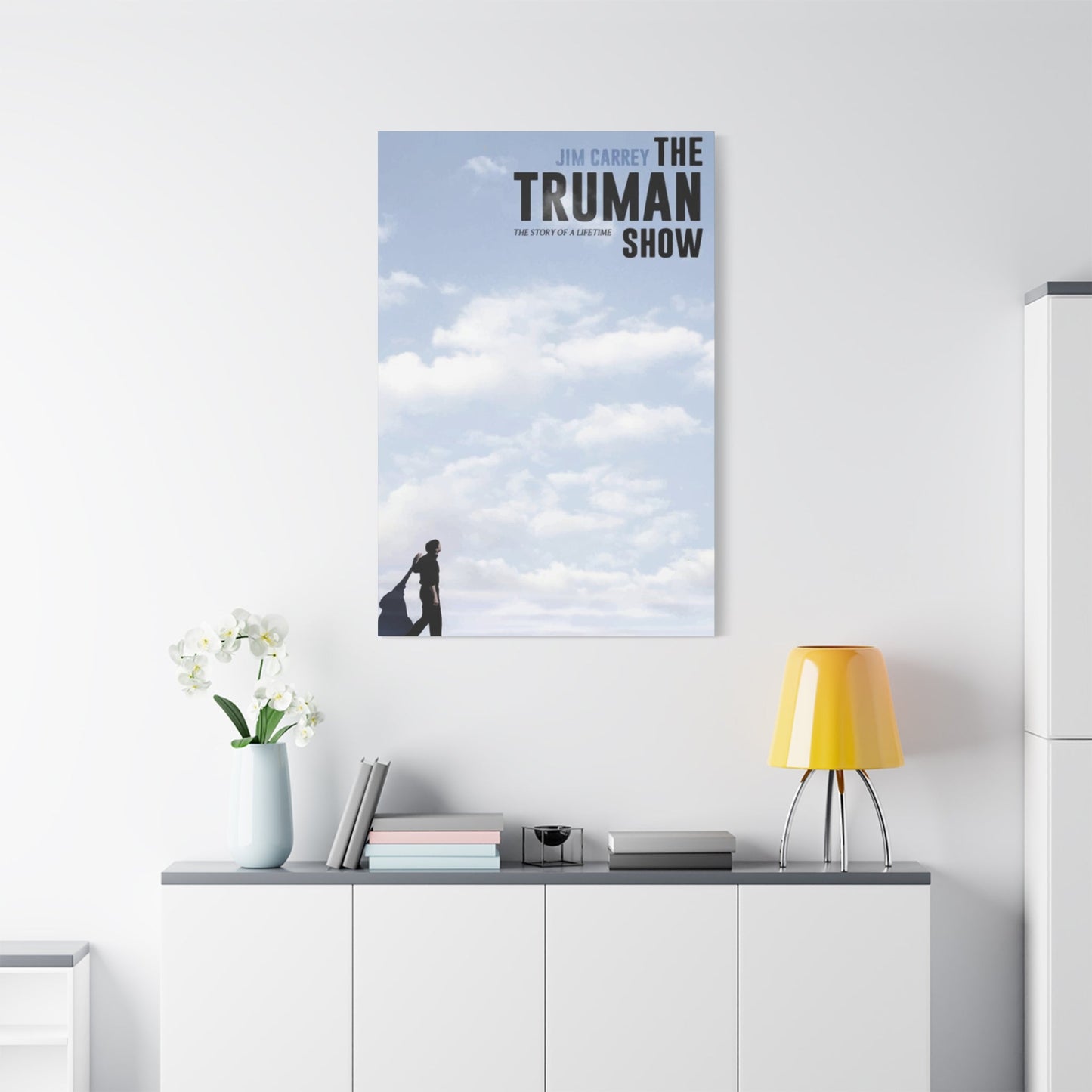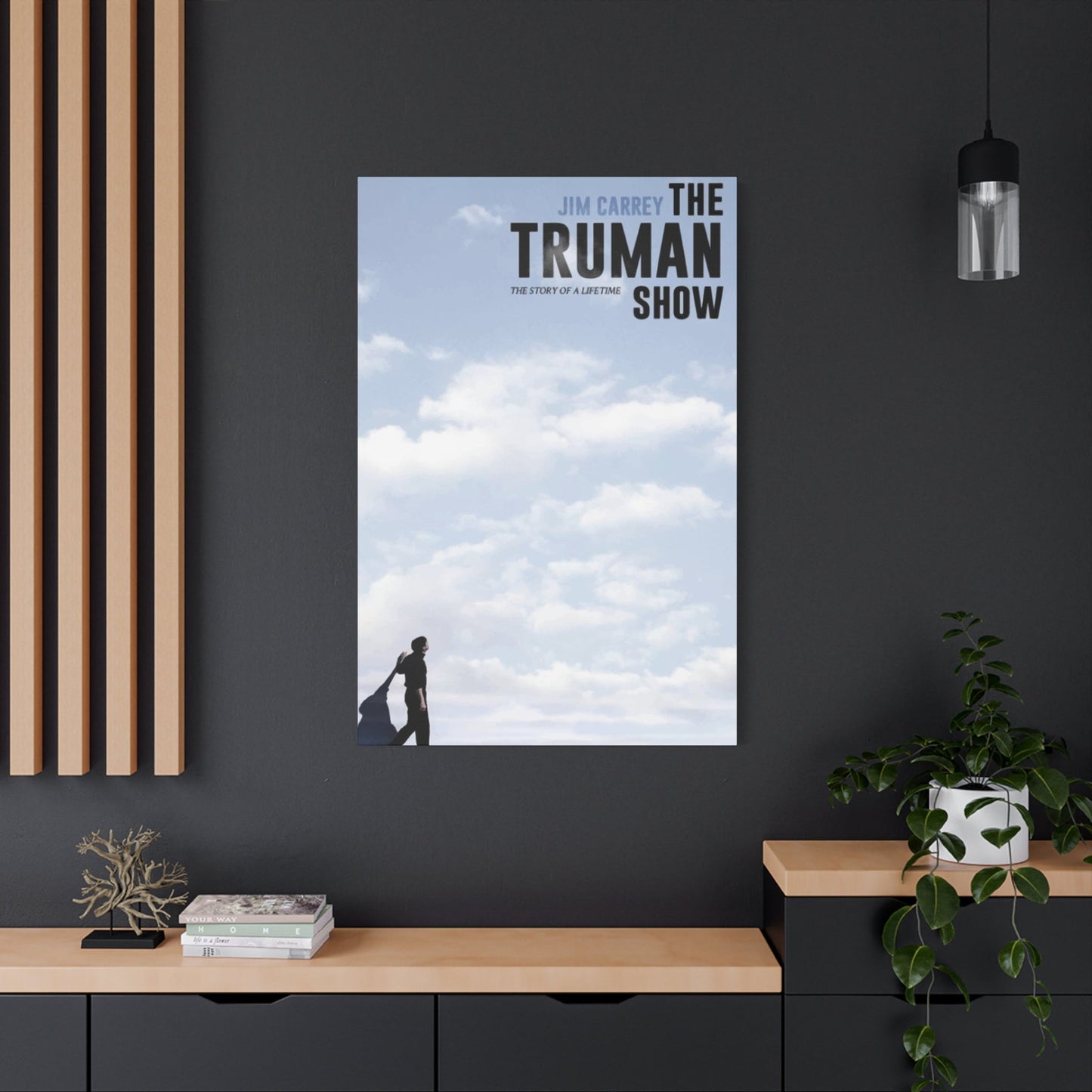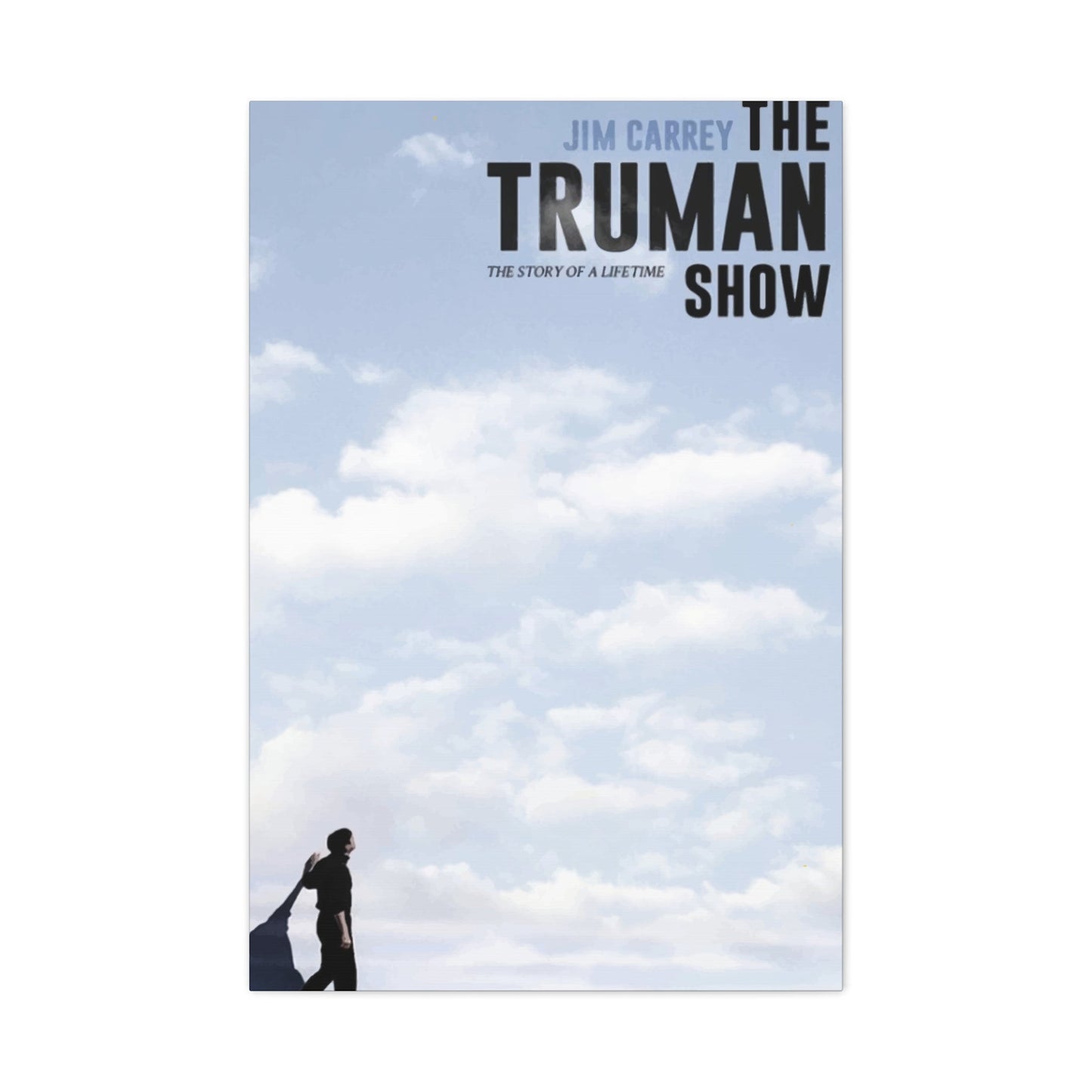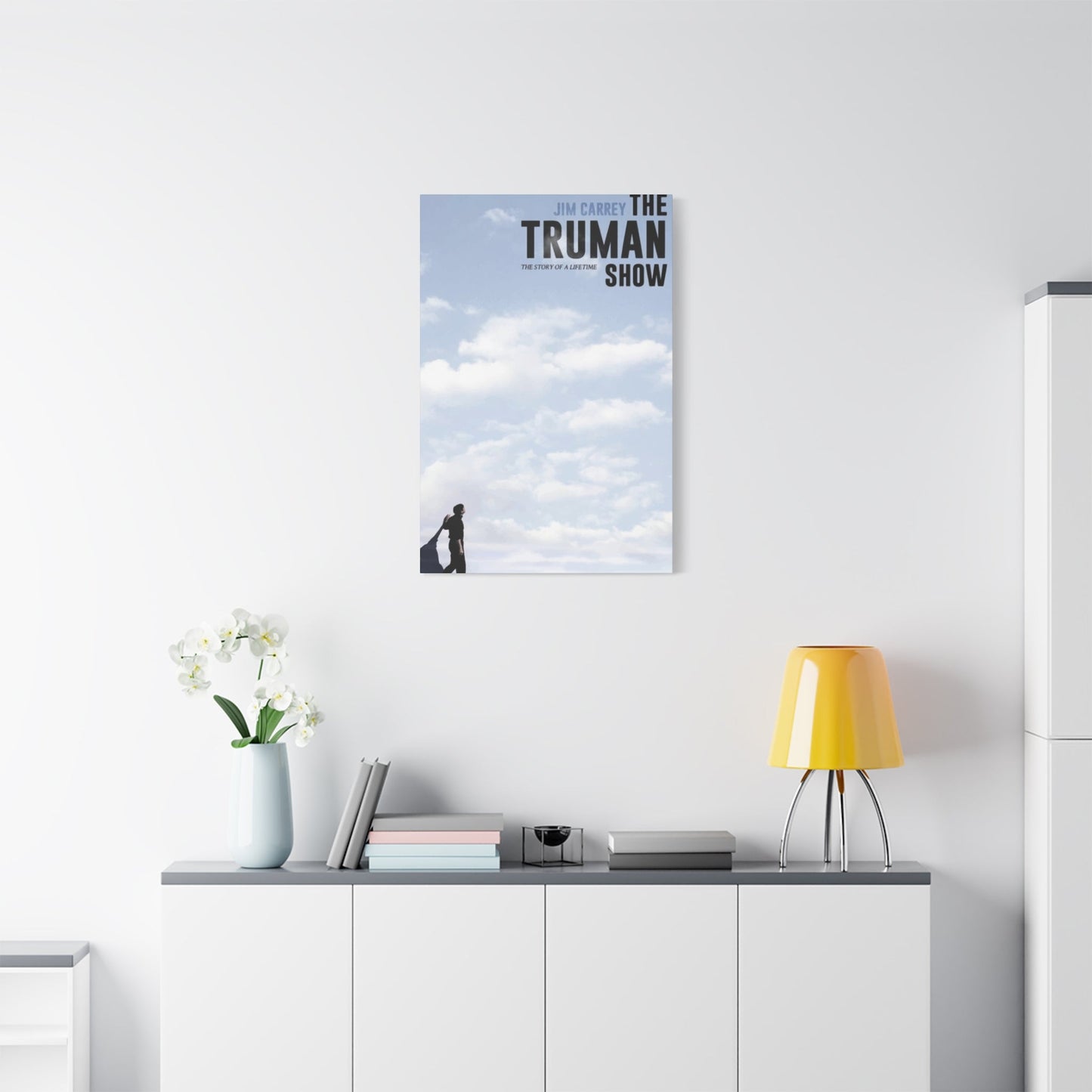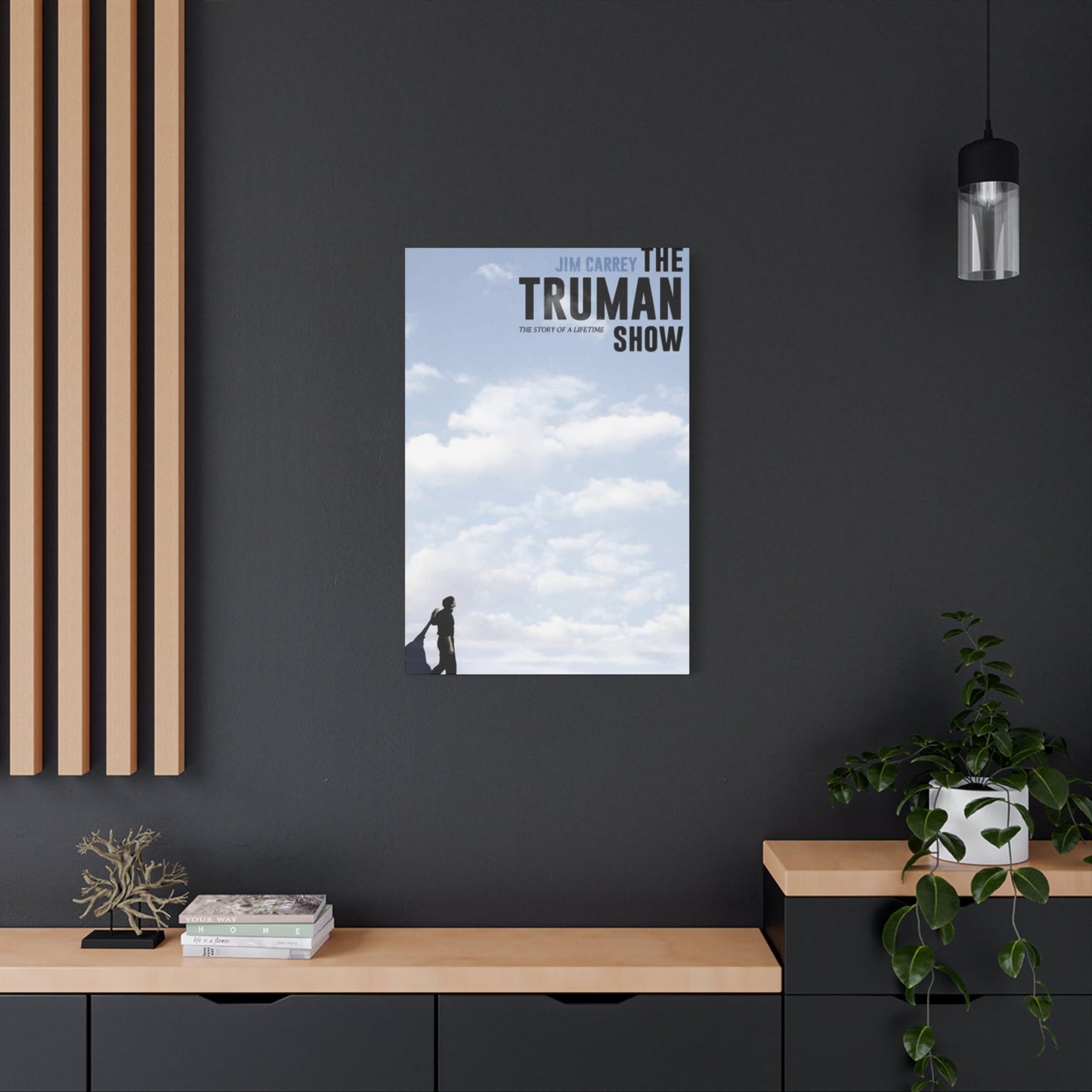Truman Show Movie Poster Wall Art: A Cinematic Classic for Your Walls
The enduring appeal of cinema-inspired interior design has created a remarkable surge in demand for memorable film artwork. Among the most sought-after pieces in this category are visual tributes to a groundbreaking 1998 psychological drama that challenged viewers to question the nature of reality itself. This particular film has transcended its original release to become a cultural touchstone, and its imagery continues to inspire homeowners, collectors, and design enthusiasts who appreciate thought-provoking entertainment. The artwork celebrating this cinematic masterpiece offers more than mere decoration; it serves as a conversation starter, a philosophical statement, and a testament to storytelling that remains relevant decades after its theatrical debut.
For those seeking to enhance their living spaces with meaningful artwork, pieces featuring this iconic film provide an exceptional opportunity to blend aesthetic appeal with intellectual depth. The visual language of this production, with its saturated colors, distinctive architecture, and memorable imagery, translates beautifully into wall art that commands attention without overwhelming a room's existing design elements. Whether you're furnishing a home theater, designing an office space, or simply looking to inject personality into your living area, these artistic representations offer versatility that few other decorative options can match.
The cultural significance of this film extends far beyond its entertainment value. It introduced concepts and visual motifs that have permeated popular culture, influencing everything from reality television discussions to philosophical debates about surveillance and authenticity. By incorporating artwork from this production into your space, you're not just displaying an appreciation for quality filmmaking; you're engaging with themes that remain urgently relevant in our digitally-mediated contemporary world. This makes such pieces particularly appealing to individuals who value decor that reflects their intellectual curiosity and willingness to engage with complex ideas.
Celebrating Cinema Through Visual Art
The intersection of film appreciation and interior design has created exciting opportunities for enthusiasts to express their passions through carefully curated wall displays. Artwork featuring this particular psychological drama represents an ideal choice for this purpose, as it combines striking visual elements with profound thematic resonance. The film's distinctive aesthetic, characterized by its artificial perfection and underlying sense of unease, creates imagery that translates exceptionally well to various artistic mediums, from canvas prints to framed posters.
When selecting pieces for your collection, consider how the specific imagery reflects different aspects of the narrative. Some representations focus on the protagonist's moment of realization, capturing the emotional intensity of discovering that your entire existence has been manufactured for entertainment. Other designs emphasize the architectural elements that made the fictional setting so memorable, with its pastel-colored houses and impossibly perfect streets. Still others incorporate the symbolic elements that film scholars have analyzed extensively, such as recurring motifs related to observation and performance.
The versatility of this artwork extends to its compatibility with various decorating styles. While you might initially assume that such pieces would only suit entertainment rooms or casual spaces, the reality is quite different. The visual sophistication of well-produced prints allows them to enhance professional environments, contemporary lofts, traditional homes, and everything in between. The key lies in selecting the right interpretation and presentation style to complement your existing decor while making the statement you desire.
Collectors and casual buyers alike appreciate how these pieces maintain their appeal over time. Unlike trendy decor that quickly feels dated, artwork celebrating this film benefits from the production's timeless themes and enduring cultural relevance. This makes such pieces a sound investment for anyone looking to build a collection that will remain meaningful and visually engaging for years to come. The film's status as a recognized classic ensures that these visual tributes will continue to resonate with viewers who discover the story for the first time and those revisiting it with fresh perspective.
Artistic Representations for Enthusiasts
Film devotees seeking to express their appreciation through home decor find particular satisfaction in curating collections that reflect their favorite productions. Artwork featuring the lead actor's most philosophically rich performance offers an exceptional way to celebrate both the performer's range and the narrative's enduring impact. This particular role showcased dramatic depth that surprised audiences accustomed to the actor's comedic work, and visual representations of key moments capture this transformative performance beautifully.
When building a collection centered around this actor's filmography, pieces from this psychological drama serve as anchor points that demonstrate the breadth of his talent. The emotional journey portrayed in this film, from blissful ignorance through growing suspicion to ultimate revelation, provides rich material for artistic interpretation. High-quality prints can capture the nuanced expressions that made this performance so memorable, allowing fans to appreciate the actor's craft every time they glance at their walls.
The artistic merit of these pieces extends beyond simple fan service. Skilled designers and illustrators have created interpretations that stand as legitimate artwork in their own right, incorporating graphic design principles, color theory, and composition techniques that elevate them beyond mere movie memorabilia. This distinction is important for collectors who want their spaces to reflect sophisticated taste while still honoring their entertainment preferences. The best examples manage to function simultaneously as tributes to beloved cinema and as aesthetically accomplished standalone pieces.
For those who appreciate this performer's entire body of work, incorporating this particular artwork into a broader collection creates interesting visual dialogues. Placing it alongside pieces from his comedic roles highlights the versatility that defines his career, while grouping it with other dramatic work emphasizes his growth as an actor. This curatorial approach transforms a simple wall display into a narrative about artistic evolution and the willingness to take creative risks that challenge audience expectations.
Strategic Placement and Design Integration
Thoughtful integration of cinema-inspired artwork requires consideration of both aesthetic principles and practical functionality. When incorporating pieces featuring this iconic film into your living spaces, the placement decisions you make will significantly impact both the visual effectiveness of the art and its ability to enhance your overall design scheme. Understanding how to position these pieces strategically ensures that they contribute positively to your environment rather than feeling like afterthoughts or creating visual clutter.
The dimensions and format of your chosen piece should inform placement decisions. Larger canvas prints or framed posters naturally serve as focal points, making them ideal for prominent wall spaces that currently feel empty or underutilized. These commanding pieces work exceptionally well above furniture arrangements, such as sofas or console tables, where they can anchor the visual composition of an entire room. The key is ensuring that the artwork's scale is proportionate to both the wall space and the furniture it's positioned above, creating visual balance rather than awkwardness.
Smaller prints offer different strategic possibilities. They can be incorporated into gallery wall arrangements, where they contribute to a larger narrative about your interests and aesthetic preferences. When creating such displays, consider how the visual elements of this particular artwork will interact with surrounding pieces. The distinctive color palette and compositional elements should complement rather than clash with adjacent items, creating a cohesive overall impression that feels intentionally curated rather than randomly assembled.
Lighting considerations play a crucial role in maximizing the impact of your chosen pieces. Artwork featuring this film often incorporates both bright, saturated colors and more subtle tonal variations, and appropriate illumination ensures that these elements remain visible and engaging. Natural light can beautifully enhance these pieces, but be mindful of direct sunlight exposure, which can cause fading over time. For spaces lacking adequate natural light, consider installing picture lights or positioning existing fixtures to highlight your artwork effectively, creating depth and visual interest even in dimly lit environments.
The relationship between your artwork and surrounding color schemes deserves careful attention. The distinctive visual palette associated with this film includes pastels, saturated blues, and warm tones that can either harmonize with or contrast against your existing wall colors and furnishings. Complementary color schemes create cohesive, calming environments, while contrasting approaches make the artwork pop more dramatically. Neither approach is inherently superior; the right choice depends on the overall atmosphere you're trying to create and how prominently you want the piece to feature in the room's visual hierarchy.
Contemporary Appeal of Classic Cinema
The enduring relevance of this 1998 film in contemporary culture speaks to its prescient exploration of themes that have only grown more urgent with time. As our lives become increasingly mediated through screens and digital platforms, the questions this narrative raises about authenticity, surveillance, and the constructed nature of reality resonate with audiences in ways that feel almost prophetic. This ongoing cultural relevance ensures that artwork celebrating this production remains fresh and meaningful rather than feeling like nostalgia for a bygone era.
Contemporary audiences discovering this film for the first time often express astonishment at how accurately it anticipated the reality television phenomenon and our current surveillance culture. The fictional world depicted in the story, where every moment is captured and broadcast to millions of viewers, feels less like science fiction and more like a slightly exaggerated version of our social media-saturated present. This prescience makes visual tributes to the film feel remarkably current, allowing them to function as commentary on our contemporary moment rather than simple celebrations of past entertainment.
The philosophical dimensions of the narrative have inspired countless academic papers, think pieces, and cultural analyses that explore its implications for how we understand consciousness, free will, and the nature of lived experience. By displaying artwork that references these themes, you're signaling an engagement with ideas that extend far beyond entertainment preferences. This intellectual dimension makes such pieces particularly appealing for professional environments like offices, libraries, or studios, where they can inspire reflection and conversation while still serving their primary decorative function.
Design professionals have noted the increasing popularity of what they term "mindful maximalism," an approach that combines abundant visual interest with intentional, meaningful selections. Artwork from this film fits perfectly within this aesthetic philosophy, offering bold visual impact while also providing the conceptual depth that mindful maximalism prizes. This compatibility with current design trends ensures that these pieces feel contemporary and fresh rather than dated, making them excellent choices for anyone looking to create spaces that feel both current and personally meaningful.
Aesthetic Flexibility for Various Environments
One of the most appealing aspects of artwork featuring this iconic film is its remarkable adaptability to different design contexts and aesthetic preferences. The visual language of the production is rich enough to support multiple interpretive approaches, from minimalist graphic designs to detailed photographic reproductions, each offering distinct decorative possibilities. This variety ensures that regardless of your existing decor style or aesthetic preferences, you can find interpretations that enhance rather than clash with your established design scheme.
For spaces embracing contemporary minimalism, graphic interpretations that distill the film's essence into clean lines and limited color palettes offer ideal solutions. These simplified designs capture the conceptual core of the narrative without overwhelming minimalist interiors with excessive visual detail. A single striking silhouette or carefully chosen quote rendered in elegant typography can make a powerful statement while respecting the restraint that minimalist design principles require. The psychological weight of the themes compensates for the visual simplicity, creating impact through conceptual rather than purely visual means.
Traditional and transitional spaces benefit from different interpretative approaches. Vintage-style reproductions that mimic original theatrical release materials bring nostalgic charm while maintaining the gravitas that established decorating schemes require. These pieces often feature the detailed illustration and typography characteristic of late-1990s film marketing, creating a sense of historical authenticity that complements classic furniture and traditional architectural details. When properly framed with materials that match the room's existing wood tones and metal finishes, these pieces integrate seamlessly into environments where more contemporary interpretations might feel jarring.
Industrial and urban loft spaces offer exciting opportunities for bold, oversized interpretations. Large-format canvas prints or metal prints featuring dramatic imagery from key scenes create striking focal points in open-plan environments with high ceilings and exposed structural elements. The theatrical nature of the source material actually complements the dramatic architectural features common in converted industrial spaces, creating a cohesive aesthetic that feels intentional and sophisticated rather than haphazard.
Eclectic and bohemian interiors, which celebrate visual diversity and unexpected combinations, provide perhaps the most flexibility for incorporating this artwork. In these contexts, pieces can be mixed with unrelated items, creating layered, personality-rich displays that tell complex visual stories. The philosophical themes of the film add conceptual depth to collections that might otherwise feel purely aesthetic, giving the overall arrangement additional resonance and meaning.
Simplified Design Elements for Refined Spaces
Contemporary design increasingly favors approaches that prioritize clarity, intention, and visual breathing room over excessive ornamentation or clutter. Within this context, simplified artistic interpretations of this beloved film offer exceptional decorative value. These pared-down designs distill complex narratives and rich visual worlds into essential elements, creating pieces that communicate powerfully without overwhelming the spaces they inhabit.
The principles underlying simplified design prioritize meaningful reduction rather than mere simplification. The most successful minimalist interpretations of this film identify the core visual or conceptual elements that make the story memorable and present them in their purest form. This might mean focusing on a single iconic image, such as the protagonist's moment of realization, rendered in a limited color palette with clean geometric forms. Alternatively, it could involve presenting a significant quote in carefully considered typography against a neutral background, letting the words carry the conceptual weight without visual distraction.
Color choices in simplified designs require particular attention. While the film itself features a relatively saturated palette dominated by pastels and bright tones, minimalist interpretations often employ more restrained color schemes. Monochromatic approaches using blacks, whites, and grays create sophisticated pieces that integrate easily into neutral interiors while maintaining visual interest through composition and form. Alternatively, single accent colors against neutral backgrounds create dramatic impact without overwhelming the viewer, making these pieces particularly effective in spaces where visual calm is a priority.
The format and presentation of simplified artwork also contributes to its effectiveness in refined environments. Float-mounted prints, where the artwork appears to hover slightly away from the background mounting surface, create subtle three-dimensionality that adds interest without breaking the clean aesthetic. Frameless mounting options or ultra-thin frames in colors that match or complement the artwork maintain visual continuity, preventing the frame from competing with the piece itself for attention. These presentation choices ensure that the artwork functions as an integrated design element rather than feeling like an addition to the space.
Typography-based designs represent another approach to simplified interpretation. Memorable quotes from the film's script can be rendered in carefully selected typefaces that reflect both the content's meaning and your space's aesthetic character. Sans-serif fonts typically convey modernity and clarity, while serif selections suggest tradition and literary quality. The spacing, sizing, and arrangement of text elements create visual rhythm and hierarchy, transforming simple words into compelling graphic compositions that reward repeated viewing.
Timeless Design from a Cinema Classic
Certain films transcend their initial release periods to become permanent fixtures in cultural consciousness, and this psychological drama undeniably belongs in that category. The staying power of classic cinema creates unique opportunities for decorators and collectors, as artwork celebrating these productions maintains relevance and appeal across decades and changing aesthetic trends. Unlike pieces tied to fleeting fads or momentary cultural phenomena, artwork from genuine classics represents a stable investment in decor that will remain meaningful and visually effective for years.
The concept of timelessness in design relates to pieces that resist dating themselves through overly trendy stylistic choices or references to temporary cultural moments. This particular film, while very much a product of the late 1990s in terms of its production context, explores universal themes that have preoccupied humans across cultures and throughout history. Questions about reality, freedom, and authentic existence are as relevant to ancient philosophers as to contemporary viewers, giving the narrative a philosophical weight that prevents it from feeling confined to its creation period.
Artwork celebrating this production benefits from this thematic timelessness. Even pieces that faithfully reproduce original theatrical marketing materials don't feel dated because the underlying story remains vitally relevant. The distinctive visual style, rather than seeming locked in the past, has actually influenced subsequent productions and design trends, giving it a foundational quality that reads as classic rather than old-fashioned. This phenomenon is similar to how we perceive certain architectural styles or fashion elements: they're recognizably from specific periods but have achieved such iconic status that they exist outside normal patterns of obsolescence.
Investing in classic film artwork also represents a form of cultural literacy and appreciation for cinema history. By displaying such pieces, you're demonstrating knowledge of and respect for foundational works that have shaped the medium. This signals sophistication and depth of taste that purely contemporary or trendy decor choices cannot convey. For professionals in creative fields, this cultural fluency can be particularly valuable, suggesting both historical knowledge and the ability to recognize enduring quality and significance.
The market for classic film memorabilia and artwork demonstrates the financial wisdom of these choices as well. While trends in contemporary art and design can be volatile, with today's hot items becoming tomorrow's clearance bin contents, artwork from recognized classics maintains stable appeal. This doesn't mean treating wall art purely as financial investment, but it does suggest that quality pieces from established classics are unlikely to lose their decorative or cultural value, making them safe choices for anyone uncertain about more experimental options.
Thoughtful Gifting Through Cinema Art
The challenge of selecting meaningful gifts intensifies as recipients accumulate life experience and material possessions, making conventional presents feel redundant or impersonal. Artwork celebrating beloved films offers a solution to this dilemma, particularly when the recipient has expressed appreciation for specific productions or performers. Canvas prints or framed posters featuring this iconic psychological drama represent gifts that demonstrate attention to the recipient's interests while providing lasting value beyond the initial presentation moment.
The success of cinema artwork as gifts depends partly on the giver's knowledge of the recipient's viewing habits and aesthetic preferences. For someone who has expressed admiration for this particular film or its philosophical themes, receiving a carefully selected artistic interpretation shows that you've been paying attention to their stated interests. This personal recognition often matters more than the monetary value of the gift itself, creating emotional resonance that generic or impersonal presents cannot achieve.
Format and presentation choices allow you to calibrate the gift to match different relationships and occasions. A high-quality framed piece suitable for immediate display represents a more substantial gift appropriate for significant occasions like housewarmings, major birthdays, or career milestones. The investment in professional framing demonstrates additional thought and effort, elevating the gift beyond simply ordering a print. Alternatively, an unframed canvas or poster provides a more casual option suitable for smaller occasions while still offering meaningful value, particularly for recipients who enjoy selecting their own framing to match their specific spaces.
The interpretative variety available in cinema artwork creates opportunities to match pieces to recipients' aesthetic preferences. Someone with minimalist tastes would appreciate simplified graphic designs, while collectors of vintage memorabilia might prefer reproduction theatrical materials. This customization potential allows you to demonstrate not just knowledge of their entertainment preferences but also understanding of their decorating style and artistic sensibilities, creating a multi-layered expression of thoughtfulness.
Group gifting scenarios offer particular opportunities with higher-quality pieces. When colleagues pool resources for a retirement gift or family members contribute toward a significant birthday present, the budget increases sufficiently to afford museum-quality pieces with premium framing and presentation. These collaborative gifts become memorable landmarks in recipients' lives, associated with specific moments and groups of people, carrying emotional weight that appreciates over time as the relationships and memories deepen.
Visual Interest Through Philosophical Themes
The decorative value of artwork extends beyond purely aesthetic considerations to encompass the intellectual and emotional engagement it inspires. Pieces featuring this groundbreaking film offer exceptional value in this regard, as the production's philosophical underpinnings ensure that the artwork functions as more than background decoration. Each viewing prompts renewed consideration of the questions the narrative raises, creating ongoing engagement that prevents the piece from fading into visual white noise as overly familiar decor often does.
The central question the film poses, regarding the nature of reality and our ability to distinguish authentic experience from convincing simulation, has only grown more pressing as virtual reality, social media, and digital mediation have become omnipresent in daily life. Artwork referencing this production thus functions as a daily reminder to remain conscious of these issues, encouraging mindfulness about how we engage with mediated experiences. This transforms the piece from mere decoration into a tool for maintaining philosophical awareness, adding practical value to its aesthetic contribution.
Visitors encountering this artwork in your space often respond with recognition and enthusiasm, creating natural conversation opportunities. The film's cultural penetration means that most people have either seen it or heard enough about it to engage with references to it, making these pieces effective ice-breakers in social situations. The conversations that emerge often move beyond simple film discussion into exploration of the deeper themes, allowing hosts to facilitate intellectually stimulating exchanges that strengthen social bonds and create memorable experiences.
The questioning of reality that defines this narrative also creates interesting parallels with art itself, particularly representation and interpretation. Artwork depicting scenes or themes from the film creates multiple layers of mediation: the film mediated reality through its narrative and cinematography; the artwork mediates the film through its particular interpretive choices; and your selection and display of the piece mediates both the film and the artwork through your curatorial decisions. This nested structure of representation can itself become a topic of reflection, particularly for those interested in aesthetics, semiotics, or media theory.
Educational environments particularly benefit from artwork with these philosophical dimensions. In academic offices, libraries, or learning spaces, pieces that prompt reflection on epistemological questions support the broader mission of these environments. Students and colleagues encountering such artwork receive subtle encouragement to think deeply and question assumptions, aligning the physical environment with educational values. This makes these pieces valuable additions to institutional spaces as well as private residences.
Specialized Spaces for Cinema Enthusiasts
Dedicated film lovers often seek to create environments that reflect their passion, and artwork selection plays a crucial role in achieving this goal. Whether designing a home theater, a personal study, or simply a living room that celebrates cinematic achievement, pieces featuring this iconic production offer exceptional decorative value. The key lies in integrating these items thoughtfully so they enhance rather than overwhelm the space, creating environments that feel curated and intentional rather than cluttered with fandom paraphernalia.
Home theaters and screening rooms represent the most obvious application for cinema artwork, but even in these contexts, thoughtful curation matters. Rather than covering every available surface with film-related items, selective placement of high-quality pieces creates more sophisticated results. A single striking image positioned where viewers see it upon entering the space or during intermissions makes a stronger impression than multiple competing pieces that dilute each other's impact. The theatrical nature of this particular film makes its imagery especially appropriate for these spaces, as the meta-textual elements about performance and spectatorship resonate with the room's function.
Personal offices and studies provide another natural home for this artwork, particularly for professionals in creative industries, philosophy, media studies, or related fields. In these contexts, the pieces function as more than decoration; they represent intellectual touchstones and sources of inspiration. A writer might appreciate the narrative complexity and structural innovation the film represents, while a philosopher values its exploration of skeptical scenarios and the problem of other minds. This functional dimension adds value beyond the purely decorative, justifying the space allocation in practical, productivity-focused environments.
Living rooms and common areas benefit from these pieces when integrated into broader decorative schemes that balance personal passion with general aesthetic appeal. The goal in shared spaces is ensuring that your individual interests enhance rather than dominate the environment, creating rooms that reflect your personality while remaining welcoming to guests with different tastes. High-quality, artistically sophisticated interpretations of the film achieve this balance better than explicitly commercial merchandise, as they read as legitimate artwork first and entertainment references second.
Collection display areas or gallery walls offer exciting opportunities for contextualizing this particular film within broader cinema history or thematic groupings. Placing it alongside other films exploring similar themes creates visual essays about surveillance, reality, media influence, or other relevant topics. Alternatively, positioning it within a chronological display of significant films from the 1990s provides historical context and demonstrates knowledge of cinema evolution. These curatorial approaches transform simple decoration into personal exhibitions that educate and engage viewers while beautifying the space.
Optimal Display Solutions for Professional Settings
Workplace environments present unique challenges and opportunities for decorative choices. While personal expression matters in professional spaces, it must be balanced against considerations of colleague comfort, client perceptions, and organizational culture. Artwork featuring this thought-provoking film can successfully navigate these considerations when selected and displayed thoughtfully, adding personality to otherwise sterile office environments without creating controversy or distraction.
The philosophical and artistic merits of this particular film make it more office-appropriate than many entertainment properties. Its themes of authenticity, freedom, and self-determination resonate with professional values without venturing into potentially controversial territory. A tastefully framed piece in a private office communicates intellectual depth and cultural literacy, potentially strengthening professional credibility rather than undermining it. The key lies in selecting interpretations that emphasize the artistic and philosophical dimensions rather than purely commercial merchandise aesthetics.
Shared office spaces require additional sensitivity regarding personal decoration. In these environments, pieces should be modest in scale and relatively neutral in tone, avoiding anything that might reasonably offend or disturb coworkers. Fortunately, many interpretations of this film lean toward contemplative and aesthetic rather than provocative, making them suitable for shared professional contexts. A smaller print featuring minimal design or a significant quote can personalize a cubicle or shared office area without imposing too heavily on others' visual experiences.
Client-facing offices and meeting spaces demand the highest level of decorative sophistication. In these environments, artwork must project professionalism and competence while potentially creating talking points that ease tension and facilitate relationship building. High-quality pieces from this film, particularly those with gallery-level production values and elegant framing, can serve these functions effectively. The cultural recognition factor helps clients feel at ease through shared cultural reference points, while the intellectual dimensions signal the kind of thoughtfulness clients appreciate in professional service providers.
Creative industry workplaces generally offer more flexibility for personal expression through office decoration. In advertising agencies, production companies, architecture firms, and similar environments, cinema artwork often feels perfectly appropriate and may even be expected as demonstration of cultural engagement and creative inspiration. In these contexts, bolder, more distinctive interpretations work well, potentially including larger-scale pieces or more experimental artistic approaches that would feel excessive in more conservative professional environments.
The practical consideration of artwork security in professional spaces also deserves attention. High-quality pieces represent both monetary and sentimental investment, making loss or damage concerning. Professional environments with good security and stable, long-term tenure justify investing in better pieces, while more transient or insecure workplaces might warrant more modest selections. This pragmatic consideration shouldn't diminish the decorating impulse entirely, but rather calibrate investment levels to match circumstances.
Excellence in Print Quality and Production
The effectiveness of any wall art depends significantly on production quality, and pieces featuring this beloved film are no exception. The difference between amateur-quality prints and professionally produced pieces dramatically affects both immediate visual impact and long-term satisfaction. Understanding the factors that distinguish superior products helps ensure your investment delivers maximum value and enduring appeal rather than disappointment when the actual item fails to match digital previews.
Print resolution represents the foundation of quality visual reproduction. Professional-grade pieces use high-resolution source imagery and printing processes that maintain clarity and detail at the intended display size. Low-resolution prints suffer from visible pixelation, color banding, and overall muddiness that cheapens their appearance regardless of other quality factors. When evaluating potential purchases, seek vendors who provide specific resolution information and use source materials appropriate for the final product dimensions. Legitimate professional operations take pride in technical specifications and willingly share them with customers.
Color accuracy and vibrancy separate exceptional prints from merely adequate ones. The distinctive palette associated with this film, with its specific tones and saturations, requires careful color management throughout the production process. Professional printers use calibrated equipment and color-managed workflows to ensure that what you receive matches the intended appearance. Archival-quality inks resist fading over time, maintaining the piece's visual integrity for years or decades rather than degrading visibly within months as inferior products often do.
The physical substrate on which images are printed profoundly affects the final result. Canvas prints offer texture and depth that create painterly qualities, lending artistic gravitas to photographic imagery. Premium canvas materials resist warping and sagging over time, maintaining taut, professional presentation. Paper prints vary widely in quality, with archival-grade fine art papers offering superior longevity and visual qualities compared to standard poster paper. Metal and acrylic prints provide contemporary alternatives with distinctive aesthetic properties, including remarkable color depth and luminosity that can make imagery appear to glow from within.
Finishing processes and mounting options represent the final quality considerations. Canvas pieces benefit from edge treatments that extend the image around the sides or provide complementary colored edges, creating finished appearances that don't require framing. Paper prints need appropriate backing boards to prevent warping and proper mounting techniques to ensure flat, even presentation. Protective finishes, when appropriate, shield surfaces from dust, moisture, and minor impacts without diminishing visual qualities. These finishing touches distinguish products that will provide lasting satisfaction from those that quickly disappoint.
Framing Choices That Enhance Visual Impact
Even the finest print requires appropriate framing to achieve its full decorative potential. The frame functions as the transition between artwork and environment, mediating their relationship and profoundly affecting how the piece is perceived. Thoughtful framing choices can elevate good prints into standout decorative elements, while poor selections can diminish even exceptional pieces. Understanding framing principles and options ensures your investment achieves maximum impact in your specific space.
Frame style represents the most immediately obvious choice, with options ranging from ornate traditional designs to sleek contemporary profiles to complete frameless mounting. The appropriate selection depends on both the artwork itself and the environment where it will be displayed. Traditional spaces with classic furniture and architectural details often call for more substantial frames with decorative elements that echo the room's established character. Contemporary and minimalist environments typically favor thin profiles or frameless options that maintain clean lines and visual simplicity.
The relationship between frame color and both artwork and environment deserves careful consideration. Frames can match, complement, or contrast with the dominant tones in the piece itself, each approach creating different effects. Matching frames create unity between image and boundary, making them recede somewhat to let the artwork dominate. Complementary colors create subtle harmonies that feel sophisticated and intentional without drawing excessive attention to the frame itself. Contrasting frames make bold statements, creating visual drama but requiring confident design sensibility to avoid awkward clashes.
Matting decisions significantly impact final presentation, particularly for paper prints. Mats create breathing room between image and frame, preventing the artwork from feeling cramped or overwhelmed. They also provide opportunities to introduce additional colors that can bridge between artwork and room, creating visual connections that integrate the piece into the broader environment. Mat width and proportion should be scaled appropriately to artwork size, with larger pieces generally requiring wider mats to maintain proper visual balance. Multiple mat layers create depth and luxury but must be executed carefully to avoid excessive ornateness.
Glazing options protect artwork while affecting its visual qualities. Standard glass provides basic protection but can create glare and reflections that interfere with viewing. Museum glass incorporates anti-reflective coatings that virtually eliminate these issues, though at significant cost premium. Acrylic glazing offers lighter weight and shatter resistance but scratches more easily than glass. The appropriate choice depends on your specific circumstances, including lighting conditions in the display location, the piece's monetary and sentimental value, and practical safety concerns, particularly in homes with children or high-traffic areas.
Blending Science Fiction Elements with Interior Design
The genre classification of this iconic film sits at an interesting intersection of science fiction, psychological drama, and social commentary. This hybridity creates unique decorative opportunities, as the imagery can appeal to audiences with different genre preferences while offering thematic richness that transcends typical genre boundaries. For those who appreciate speculative fiction exploring technology's implications or dystopian scenarios examining social control, artwork from this production provides an entry point into these ideas within your living environment.
The science fiction elements manifest less through technological spectacle than through conceptual premises that question reality's nature. This philosophical approach to speculative storytelling creates visual possibilities quite different from space opera or hard science fiction. Rather than spacecraft and futuristic cities, the imagery centers on uncanny everyday environments and the protagonist's psychological journey. This grounded aesthetic makes the artwork accessible even to those who typically don't engage with science fiction, broadening its appeal beyond genre enthusiasts to include anyone interested in reality's constructed nature.
The dramatic dimensions balance the speculative elements, creating emotional resonance that pure science fiction sometimes lacks. The protagonist's journey from contentment through confusion to ultimate self-determination provides a human story that grounds the high-concept premise. Artwork capturing these emotional beats appeals to viewers interested in character-driven narratives and psychological depth rather than purely conceptual speculation. This balance allows the pieces to function in contexts where explicitly science-fiction artwork might feel inappropriate or tonally inconsistent.
Contemporary interior design increasingly embraces eclectic approaches that mix genre signifiers and cultural references playfully. Within this context, science fiction elements read as sophisticated cultural literacy rather than niche fandom. The speculative tradition's literary prestige and philosophical engagement elevate it beyond mere entertainment, making references to significant works feel intellectually substantial. Artwork from this particular film benefits from this cultural positioning, carrying genre associations while also being recognized as serious cinema exploring profound themes.
The resurgence of interest in retrofuturism and 1990s aesthetics has created additional design opportunities for this particular film's imagery. The production design's specific character, with its artificial perfection and slightly uncanny tone, captures a particular moment in design history while also feeling timeless due to the intentional artificiality. This temporal ambiguity allows the artwork to function in both vintage-inspired and contemporary spaces, creating flexibility that enhances its decorative value across different design approaches.
Cultural Resonance Across Multiple Decades
The remarkable staying power of this 1998 film in cultural consciousness speaks to its thematic prescience and narrative craftsmanship. While many productions from this era feel dated today, this particular work has aged exceptionally well, with its core concerns becoming increasingly relevant as technology and media continue their evolution. This ongoing cultural resonance ensures that artwork celebrating the production maintains freshness and relevance rather than feeling like nostalgia for a bygone era.
The film's release preceded several major cultural developments that it eerily anticipated. Reality television exploded in popularity shortly after, with shows constructing elaborate scenarios and manipulating participants in ways that echo the film's central premise. The surveillance capabilities that seemed extreme in the narrative context have been far exceeded by actual technological developments in the decades since. Social media's emergence created new dynamics where individuals voluntarily broadcast their lives to audiences of strangers, ironically inverting the film's scenario of unwilling surveillance into chosen performance.
These parallels ensure that new viewers continue discovering the film and finding it urgently relevant to contemporary experience. Each generation encounters it from their specific cultural moment, finding different elements resonant based on prevailing concerns. Early viewers focused on reality television implications, while later audiences emphasize surveillance and privacy issues, and current viewers often draw connections to social media performance and authentic identity construction. This interpretive flexibility keeps the film alive in cultural discourse rather than consigning it to historical archives.
Educational contexts have embraced the film as teaching material for courses in philosophy, media studies, sociology, and communication. Academic engagement ensures ongoing critical attention that maintains cultural visibility and intellectual credibility. Students encountering the material in academic contexts often develop lasting appreciation that extends beyond their coursework, creating successive waves of enthusiasts who seek out artwork and other tributes. This academic adoption functions as a form of cultural preservation that benefits creators and vendors of related merchandise and artwork.
The anniversary cycle of film releases creates periodic opportunities for renewed attention and exposure. Twenty-fifth anniversary celebrations occurred in 2023, introducing the film to audiences who weren't alive for its original release while allowing longtime fans to revisit it with accumulated life experience. These milestone moments drive increased interest in related artwork and merchandise, though quality pieces maintain consistent appeal rather than depending on anniversary-driven attention spikes.
Contemporary Living Spaces Enhanced by Cinema Art
Modern residential design has evolved toward open floor plans, clean lines, and carefully curated decorative elements that reflect occupant personality without creating visual clutter. Within this context, cinema artwork serves multiple valuable functions. It personalizes otherwise neutral spaces, creates focal points that organize visual attention, and demonstrates cultural engagement and intellectual depth. Pieces featuring this iconic film particularly excel at these functions due to the production's visual distinctiveness and thematic weight.
Open-concept living areas benefit significantly from strategic artwork placement. These expansive spaces need visual anchors that define distinct zones without erecting physical barriers that would defeat the open plan's purpose. A substantial canvas print or framed poster positioned above seating areas helps define conversational zones, while pieces placed in dining or home office areas within the larger space reinforce those functional distinctions. The artwork thus contributes to spatial organization while beautifying the environment and expressing personal taste.
Contemporary design's emphasis on authenticity and meaningful curation over mere decoration creates particular opportunities for cinema artwork. Rather than selecting pieces solely for color coordination or generic appeal, contemporary design philosophy encourages choices that reflect genuine interests and passions. Artwork featuring films you actually love and find intellectually engaging fits perfectly within this approach, demonstrating the authenticity of contemporary design prizes. The key lies in selecting high-quality interpretations that honor both the source material and design principles rather than compromising either.
Conclusion
The Truman Show is a film that has captivated audiences worldwide with its unique blend of satire, philosophy, and emotional depth. As a cinematic classic, it continues to inspire reflection on reality, identity, and the nature of freedom. Bringing the essence of this iconic movie into your living space through Truman Show movie poster wall art offers a way to celebrate its cultural impact while adding a striking visual statement to your décor. This art form combines nostalgia with artistic expression, making it an ideal choice for film lovers and art enthusiasts alike.
Movie posters have long been more than just promotional materials; they are collectible pieces of art that capture the spirit and essence of a film. The Truman Show poster, with its distinctive imagery and thought-provoking themes, embodies this tradition perfectly. Displaying this artwork on your walls serves as a constant reminder of the film’s exploration of human experience and the search for authenticity in a world full of illusions. It sparks conversations, inspires curiosity, and keeps the movie’s powerful messages alive in everyday life.
Moreover, Truman Show movie poster wall art offers versatility and aesthetic appeal. Whether you prefer vintage-style prints that evoke the original 1998 release or modern reinterpretations that emphasize the film’s themes through creative design, there are countless options to suit various tastes and décor styles. This flexibility makes it easy to incorporate the poster into diverse environments, from contemporary living rooms to home theaters or creative workspaces. The bold colors, iconic typography, and symbolic imagery found in Truman Show posters can complement both minimalist and eclectic interiors, adding personality and depth.
Beyond its decorative function, this wall art also serves as a source of inspiration and introspection. The film challenges viewers to question the nature of reality and encourages authenticity and self-awareness. Having the poster prominently displayed invites daily reflection on these themes, motivating individuals to examine their own lives and the world around them. It acts as a visual catalyst for deeper thought, encouraging viewers to embrace their individuality and challenge societal norms—just as Truman did.
Furthermore, the enduring popularity of The Truman Show highlights its cultural relevance decades after its release. As society continues to grapple with issues of surveillance, media influence, and the blurred lines between reality and entertainment, the movie’s message remains timely and resonant. Displaying Truman Show movie poster wall art connects you to this ongoing conversation, serving as a reminder of the film’s prescient insights and its place in cinematic history.
In conclusion, Truman Show movie poster wall art is more than just a decorative element—it is a tribute to a groundbreaking film that continues to provoke thought and inspire viewers. It offers a unique blend of nostalgia, artistic expression, and philosophical depth that enriches any space. Whether you are a longtime fan or discovering the film’s significance for the first time, this wall art invites you to celebrate the story of Truman Burbank and his journey toward truth and freedom. By bringing this cinematic classic into your home, you not only enhance your décor but also keep alive the powerful messages that make The Truman Show a timeless masterpiece.












